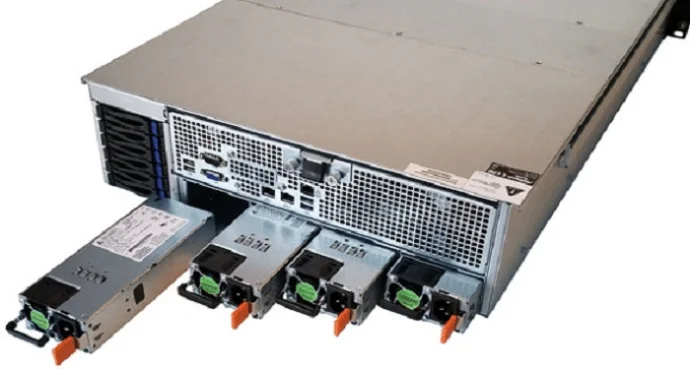How To Size UPS Systems In kVA and kW
Within a server room or datacentre environment an uninterruptible power supply should be sized to meet day-one loads and provide additional capacity for future expansion. A UPS system is just one element of the critical power path which can also include building incomers, transformers, LV switchboards, switchgear, distribution panels and power distribution units. It is critically important that each element is sized correctly and there are two ways to calculate the power being drawn which can be measured in VA or Watts.
The Difference Between VA and Watts
VA measures the ‘Apparent Power’ being drawn with the formula being: load amperage (Amps) drawn multiplied by the mains power supply voltage (V). To work out the kVA the VA is multiplied by 1000.
Watts measures the ‘Real Power’ drawn by a device or system. This is the reading used by electrical utility companies to charge for the hourly electricity used and is normally expressed as kWh (kilowatt-hours) or MWh (Mega Watt Hours) or GWh (Giga Watt hours). In some environments such as a co-location (co-lo) datacentre clients are charged for the electricity their dedicated servers and IT systems draw by as on their kWh usage. In terms of electrical efficiency, the most commonly used measure in a datacentre is Power Usage Efficiency (PUE) where PUE = Total Facility Energy / IT Equipment Energy with both ‘Energy’ values measured in Watts.
When sizing a UPS system, the power protection specialists at Server Room Environments will calculate bot the VA and Watts used in order to accurately size a UPS system. Real Power is also used for battery runtime calculations and the right value is critical to ensuring the UPS battery is sized to provide the backup power time required.
Calculating Apparent Power
In order to calculate the Apparent Power (VA), it is important to know whether the mains power supply is a single phase or three phase supply and whether the loads are drawing three or single phase. It is possible to supply three basic configuration of UPS system referred to as a single-phase output (1/1 or 3/1) or three phase output referred to as a 3/3 configured system.
Electrical Supply and Distribution Considerations
When assessing the electrical supplies it is also important to consider other factors including:
- Load currents (Amps) for normal running and on start-up
- Load power draw (Watts)
- Energy efficiency measures including eco-operation and standby/sleep modes
- Upstream electrical distribution and breaker types and sizes for safe discrimination
- Electrical cable sizes, ratings and lengths
- Downstream power distribution and power cord arrangements
Measurements can be made using RMS meters and these will be more accurate than referring to rating plates or manuals or specifications which will simply state maximum design values. Small single-phase UPS systems may be based on VA ratings but larger systems above 3kVA are best sized according to the Watts Real Power required.
Supply and Load Power Factors (kVA vs kW)
The relationship between VA and Watts is referred to as a ratio known as the Power Factor (pF). In order to achieve the best operating efficiencies many loads are moving towards Unity power factor where the ratio equals ‘1.0’. In this instance the kVA to kW or kW to kVA calculation conversion factor is 1.
UPS systems will have both an input power factor and an output power factor. The input power factor is the load of the UPS system on the local mains power supply or a standby power generator. Modern UPS systems are moving towards Unity and at least greater than 0.9 to improve electrical energy efficiency. The higher the input power factor, the more closely matched the input current and voltage waveform requirements of the UPS system to the mains or generator supply.
Output power factors can also vary between UPS systems. An uninterruptible power supply with an output power factor of 0.8 at 100kVA will deliver 80kW i.e. 100*0.8 where as a UPS system with a Unity power factor will deliver 100kW of power.
Switch Mode Power Supplies
At the heat of a server or computer is a switch mode power supply (SMPS) which takes the incoming mains power or generator AC (alternating current) and converts this into the DC (direct current) levels required to power internal circuits and central processing units.
To improve electrical energy efficiency and reduce their impact on the mains power supply, SMPS power supply manufacturers have adopted a Unit or near Unity input power factor for their devices. This change in approach makes sizing uninterruptible power supplies ‘interesting’ as there can be a real difference in the real power (Watts) required between legacy power supplies and modern power supplies.
Older computer and server power supplies may be rated as low as 0.6 power factor. Whilst they require 1000VA UPS their actual real power requirement may only be 600W. A more modern power supply rated at 1000VA Unity would require a 1000W supply. Within a datacentre or server room environment with a high deployment of servers the different power factors can lead to weak or incorrect UPS sizing if not allowed for.
Legacy UPS System Upgrades
Where a legacy UPS is being considered for swap out, a more modern and Unity output rated UPS systems will be smaller and more compact. This is not just by design but also by being able to deliver more real power kilowatts. A 100kVA UPS rated at 0.8pF could require a replacement UPS size of 80kVA if the new unit is Unity rated where 80kVA=80kW.
Please contact our power protection consultants for further information on our UPS systems and sizing formulae. In addition to technical support, we provide free energy storage and UPS site surveys across the UK and Eire.


























